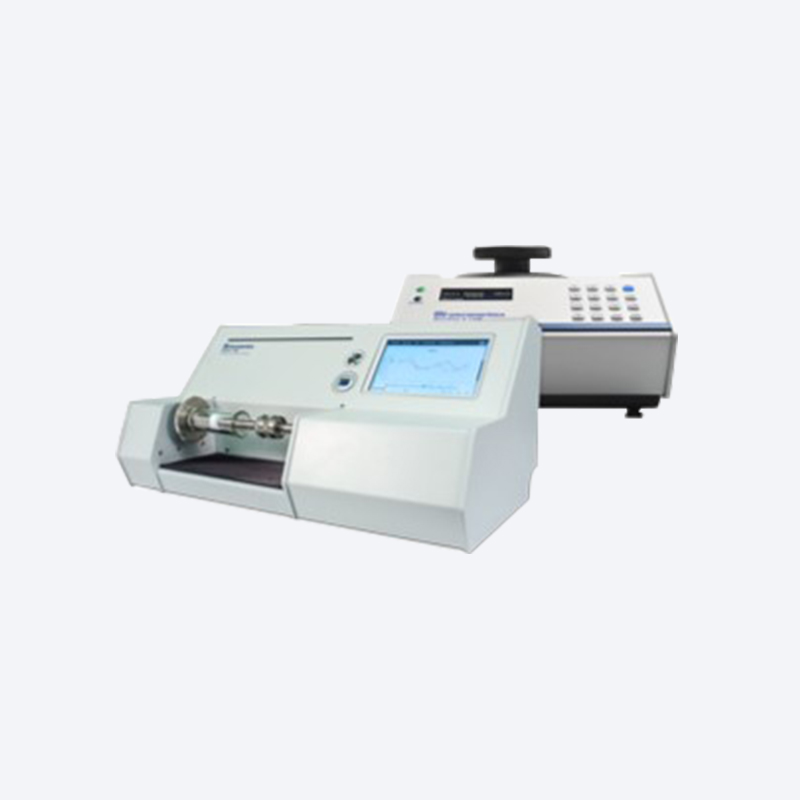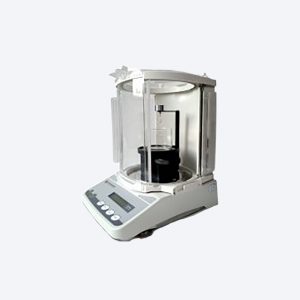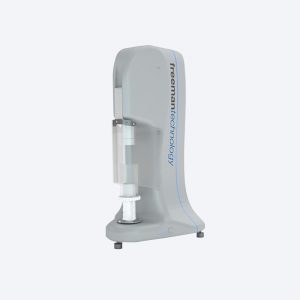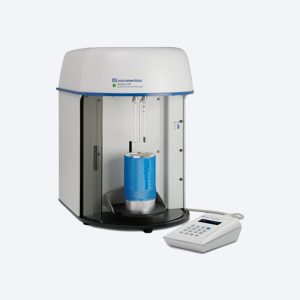Description
The GeoPyc automatically determines the volume and density of a solid object by displacement of Dry Flo, a solid medium. The medium is a narrow distribution of small, rigid spheres that have a high degree of flow ability and achieve close packing around the object under investigation. The particles are sufficiently small that during consolidation they conform closely to the surface of the object, yet do not invade pore space.
Repeatability and reproducibility are achieved by a controlled method of compaction. The sample cell in which the dry medium is placed is a precision cylinder. A plunger compresses the powder as the cell vibrates; the force of compression is selectable and, therefore repeatable from test to test. A preliminary compaction with only the displacement medium in the cell establishes a zero-volume baseline.
The sample is then placed in the cylinder with the dry medium and the compaction process is repeated. The difference in the distance ht the piston penetrates the cylinder during the test and the distance h0 it penetrates during the baseline procedure (h= h0 – ht) is used to calculate the displacement volume of the medium using the formula for the volume of a cylinder of height h, V= π r2h
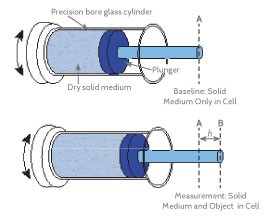
Reporting Functions
The GeoPyc has multiple operational modes that are accessed through the instruments smart touch screen. Operating modes including full blank, computed blank, and reference solid calibration with variance, which allows you to optimize speed and accuracy for your specific application.
During analysis, indications of progress and preliminary results make it possible to track what is occurring. Sample-specific information can be entered into the analysis reports.
Available Reports:
- Envelope Density
- Volume Calibration
- Blank Report
- Force Calibration
- Instrument Log
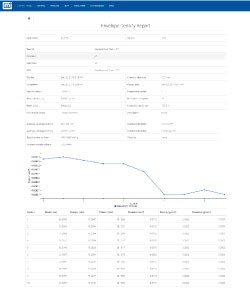
Total
On an elementary level, the volume of a solid material can be calculated by measuring its length, width, and thickness. However, many materials have within their structure surface irregularities, small fractures, fissures, and pores.
Some of these voids or pores are open to the surface or closed within the structure of the solid material. Therefore, differences in the material volume depend on the measurement technique, measurement method, and the conditions under which the measurements were performed.

| Density Type | Definition | Material Volume | Open-PoreVolume | Closed-PoreVolume | Inter particle Volume | External Void Volume | Addressed by |
|---|---|---|---|---|---|---|---|
| True (Absolute) | The mass of a substance divided by its volume, excluding open and closed (or blind) pores | ✔ | AccuPyc II | ||||
| Skeletal(Apparent) | The ratio of the mass of the solid material to the sum of the volume including closed (or blind) pores | ✔ | ✔ | AccuPyc II | |||
| Envelope | The ratio of the mass of a substance to the envelope volume (imaginary boundary surrounding the particle) | ✔ | ✔ | ✔ | ✔ | ✔ | GeoPyc |
| Bulk | Mass of the material divided by the volume occupied that includes interstitial space | ✔ | ✔ | ✔ | ✔ | GeoPyc | |
| TAP | Apparent powder density obtained under stated conditions of tapping | ✔ | ✔ | ✔ | ✔ | GeoPyc with T.A.P. function |
Operational Features
The GeoPyc is operated from an intelligent touch screen. Data acquisition and reporting are fully automated for convenient incorporation in LIMS or other data concentrating systems.
A variety of sample chambers is available to accommodate a wide range of sample sizes. After the analysis, a light shaking or dusting completely removes the Dry Flo so the samples can be reused or retested. The GeoPyc has multiple operating modes including full blank, computed blank, and reference solid calibration with variance, which allows you to optimize speed and accuracy for your individual needs. During analysis, indications of progress and preliminary results make it possible to track what is occurring.
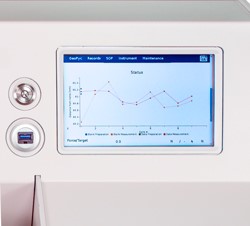
T.A.P Density Option
The GeoPyc T.A.P. density option obtains precise results comparable to conventional tap density analyzers, only it does it faster, quieter, and with a higher degree of reproducibility.
When equipped with the T.A.P. Density option, the GeoPyc measures the packing volume and calculates the bulk density of granular and powdered samples, including pharmaceutical and electrochemical materials, under a wide range of compaction conditions.
To determine T.A.P. density, the sample chamber is rotated and agitated while a precise specified force is applied to the sample. A force transducer measures the consolidation force in Newtons and the distance over which the consolidation piston and plunger travel is measured in steps. The user specifies the force applied and the number of consolidations per analysis. The GeoPyc averages the measurements from each consolidation and automatically calculates volume and density, and reports the results in cm3 and g/cm3.
Micromeritics Porosity Instrument Bundle
While skeletal and envelope volume measurements are significant in their importance as individual capacities, their combination permits the pharmaceutical scientist to also accurately calculate percent porosity and total pore volume. With this data a process engineer or quality assurance scientist can have greater knowledge of their process for improvement in both quality of product and optimization of the manufacturing process.
GeoPyc Envelope Density Analyzer
The GeoPyc utilizes a quasi-fluid displacement medium composed of non-hazardous microspheres having a high degree of flowability that do not wet the sample or fill its pores.
- Determines envelope volume and density of monolithic samples as well as bulk volume and density of powdered materials
- A variety of sample chambers is available to accommodate a wide range of sample sizes
- T.A.P. Density option – measures the packing volume and calculates the bulk density of granular and powdered samples
AccuPyc/GeoPyc Porosity Bundle Bundle
The AccuPyc II 1340 Series Pycnometers are fast, fully automatic pycnometers that provide high-speed, high-precision volume measurements and true density calculations. The instrument completes most sample analyses in less than three minutes without sacrificing accuracy or compromising sample integrity.
- Non-destructives test with speed
of analysis - Eliminate errors with programmable
auto repeat and data acquisition to a selected SOP - Adaptable configuration to accommodate samples of varying volumes

